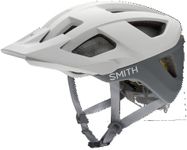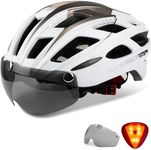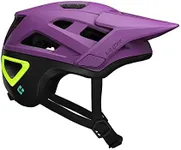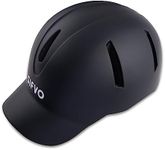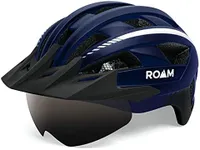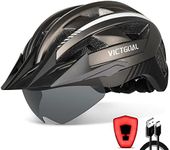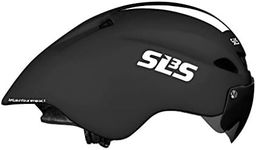Buying Guide for the Best Bicycle Helmets With Visors
Choosing the right bicycle helmet with a visor is crucial for ensuring your safety and comfort while riding. A good helmet not only protects your head in case of an accident but also provides additional features like a visor to shield your eyes from the sun, rain, and debris. When selecting a helmet, it's important to consider several key specifications to find the best fit for your needs. Here are the main factors to keep in mind when shopping for a bicycle helmet with a visor.Fit and SizeThe fit and size of a helmet are critical for safety and comfort. A helmet that is too loose or too tight can be uncomfortable and may not provide adequate protection. Helmets come in various sizes, usually measured in centimeters around the head. To find the right size, measure the circumference of your head just above your eyebrows. Helmets often have adjustable straps and dials to fine-tune the fit. Make sure the helmet sits level on your head and doesn't move when you shake your head.
Safety StandardsSafety standards ensure that a helmet can protect you effectively in case of an accident. Look for helmets that meet recognized safety standards such as CPSC (Consumer Product Safety Commission) in the US, EN 1078 in Europe, or AS/NZS 2063 in Australia/New Zealand. These certifications indicate that the helmet has passed rigorous testing for impact resistance and other safety features. Always choose a helmet that meets or exceeds these standards to ensure maximum protection.
VentilationVentilation is important for keeping your head cool and comfortable during rides, especially in hot weather. Helmets come with various numbers and sizes of vents. More vents generally mean better airflow but can also mean less material for protection. For casual riders, a helmet with moderate ventilation should suffice. For long-distance or high-intensity cyclists, look for helmets with more vents to ensure adequate cooling.
WeightThe weight of a helmet can affect your comfort, especially on long rides. Lighter helmets are generally more comfortable but can be more expensive. The weight of a helmet is usually listed in grams. For casual riders, a slightly heavier helmet may be acceptable, while competitive cyclists might prefer a lighter option to reduce fatigue. Consider how long and how often you ride to determine the importance of helmet weight for you.
VisorThe visor on a helmet helps protect your eyes from the sun, rain, and debris. Visors can be fixed or removable. A fixed visor is more stable but less versatile, while a removable visor offers flexibility depending on the riding conditions. If you ride in varying weather conditions or different times of the day, a removable visor might be more convenient. Consider the length and angle of the visor to ensure it provides adequate protection without obstructing your view.
Padding and ComfortPadding inside the helmet adds to the comfort and can help with fit. Look for helmets with removable and washable padding to keep the helmet clean and fresh. The padding should be soft and not cause any pressure points on your head. Some helmets also offer antimicrobial padding to reduce odor. If you plan to ride frequently, prioritize helmets with high-quality, comfortable padding.
AdjustabilityAdjustability features like straps, dials, and retention systems help you achieve a secure and comfortable fit. Helmets with more adjustability options can be fine-tuned to fit your head shape better. Look for helmets with easy-to-use adjustment mechanisms that you can operate even while wearing gloves. A well-adjusted helmet stays in place and provides better protection.
Style and DesignWhile not as critical as safety features, the style and design of a helmet can influence your choice. Helmets come in various colors, shapes, and designs. Choose a style that you feel comfortable wearing and that matches your personal taste. Some helmets also have reflective elements or mounts for lights, which can enhance your visibility and safety during rides.


